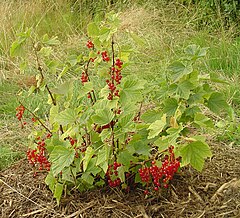The Red currant (Ribes rubrum) is a member of the genus Ribes in the gooseberry family Grossulariaceae, native to parts of western Europe (Belgium, France, Germany, Netherlands, Northern Italy and Northern Spain). It is a deciduous shrub normally growing to 1-1.5 m tall, occasionally 2 m, with five-lobed leaves arranged spirally on the stems. The flowers are inconspicuous yellow-green, in pendulous 4-8 cm racemes, maturing into bright red translucent edible berries about 8-12 mm diameter, with 3-10 berries on each raceme.
There are several other very similar species native in Europe, Asia and North America, also with edible fruit, though usually considered to have an inferior flavour. These include Ribes spicatum (northern Europe and northern Asia), R. schlechtendalii (northeast Europe), R. multiflorum (southeast Europe), R. petraeum (southwest Europe) and R. triste (North America; Newfoundland to Alaska and southward in mountains).
Cultivation and uses

Redcurrant fruit is slightly more sour than its relative the blackcurrant, and is cultivated mainly for jams and cooked dishes, rather than for eating raw. For example, in Scandinavia it is often used in fruit soups and summer puddings, and in Germany it is also used in combination with custard or meringue as a filling for tarts. However, unlike the cranberry, it certainly can be enjoyed in its fresh state and without the addition of sugar.
Although blackcurrant is more traditionally associated with medicinal uses, English and German language herbalist sources consider redcurrant berries to have fever-reducing, sweat-inducing, menstrual-flow inducing, mildly laxative, astringent, appetite increasing, blood cleansing, diuretic and digestive properties. Some of these proposed effects are probable, due to the verified high levels of vitamin C, fruit acids, and fiber the berries contain. Tea made from dried redcurrant leaves is said to ease the symptoms of gout and rheumatism, be useful in compresses for poorly healing wounds, and as a gargling solution for mouth infections.
According to the "Orbis Naturführer" (Orbis Verlag, Munich, 2000), while Ribes rubrum and R. nigrum are native to northern and eastern Europe, large berried cultivars of the redcurrant were first produced in Belgium and northern France in the 1600s. In modern times, numerous cultivars have been selected; some of these have escaped gardens and can be found in the wild across Europe and extending into Asia.
The white currant is also a cultivar of Ribes rubrum, being merely a less sour and colourless variant of the redcurrant, and not a separate species, though sometimes being named Ribes sativum or Ribes silvestre, and sold as a different fruit.
| Red currant | ||||||||||||||
|---|---|---|---|---|---|---|---|---|---|---|---|---|---|---|
 Cultivated redcurrant | ||||||||||||||
| Scientific classification | ||||||||||||||
| ||||||||||||||
| Binomial name | ||||||||||||||
| Ribes rubrum L. |


Tidak ada komentar:
Posting Komentar